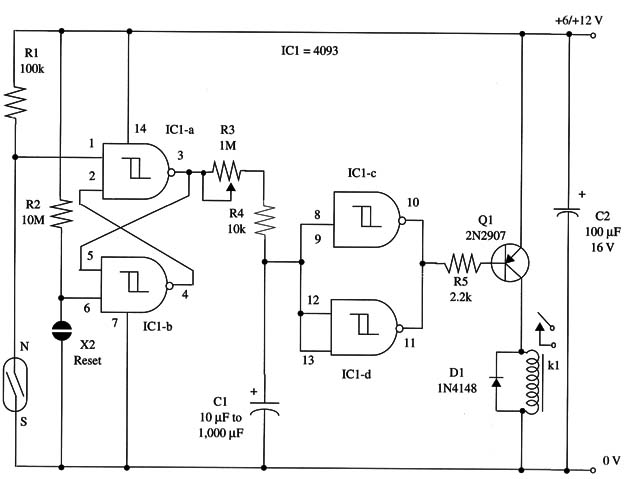Other sensors can be wired in parallel with X1 to protect more positions. Reset is accomplished by a touch sensor or, if you prefer, an SPST momentary switch.
The circuit works as follows. When the sensor X1 is closed, IC1-a output goes low, and then its output goes high. At this moment, C1 begins to charge through R3 and R4 until IC1-c and d trigger on. After this, the transistor is biased, driving the relay (K1).
The device can be powered from 6 V or 12 V power supplies (battery or ac-to-dc converters). A 12 V, 1 A DPDT mini relay (Radio Shack 275-249) is suitable for this project.
A schematic diagram of the Delayed Alarm is shown in Fig. 1.

Proper positioning of the polarized components (transistor, electrolytic capacitors, and diode) must be observed.
To operate the unit, set R3 at the minimum resistance and touch X2 to reset the circuit. Then, engage X1 to trigger the alarm. After the adjusted time delay, you will hear the relay closing its contacts.
Repeat this operation and, using a watch, set R3 to give the desired time delay.
IC1 - 4093 CMOS integrated circuit
Q1 - 2N2907 PNP general purpose silicon transistor
D1 - 1N4148 general purpose silicon diode
K1 - 6 V or 12 V relay (see text)
X1 - Magnetic or momentary switch, normally open (see text)
X2 - Touch sensor or SPST momentary switch (see text)
R1 - 100,000 Ω, 1/4 W, 5% resistor
R2 - 10,000,000 Ω, 1/4 W, 5% resistor
R3 - 1,000,000 Ω - potentiometer or trimmer pot
R4 - 10,000 Ω,1/4 W, 5% resistor
R5 - 2,200 Ω, 1/4 W, 5% resistor
C1 - 10 µF to 470 µF, 16 WVDC electrolytic capacitor (see text)
C2 - 100 µF, 16 WVDC electrolytic capacitor